Vanished Boschlust
A few months ago, an avid reader invited me to his home for coffee. He told me he'd worked with copywriters in his career and enjoyed my stories. Out of the corner of my eye, I spotted a poster-sized photo depicting Zadelstraat in Utrecht circa 1895, with the horse-drawn tram in the direction of the Dom Tower, and on the left a poster saying "Open Café Restaurant Boschlust on Mooie Laantje Zeist." His wife asked if I also wrote about houses in Zeist that no longer exist. Her grandparents, Mr. and Mrs. Hoogland, former hoteliers from Reeuwijk, owned Café-Hotel Boschlust from 1934 to 1959. After it was sold to the municipality by the Dutch Reformed Church, her parents, the Hooglands and former owners of Hotel Hoogland in Blerick, near Venlo, managed the building on behalf of the foundation board from 1964 to 1989. Wim and Riet Hoogland lived in Boschlust on the corner of Boschlaan and Prof. Lorentzlaan, just as his parents had done before, together with their family. Wim and Riet's daughter told me that her sister still had four scrapbooks about Boschlust compiled by her mother, which I would be happy to see. The names Boschlust and Hoogland have been linked for 50 years, and both were very important to the social and cultural life of our community.
Because in 1994, after moving from Brugakker to Rozenstraat in the center of Zeist, we received the old phone number of Boschlust, which had burned down in 1993. For two years, I received all the associated calls for information and reservations from callers who persistently ignored me and told me that Boschlust had burned down and been demolished, I decided to take on this challenge.
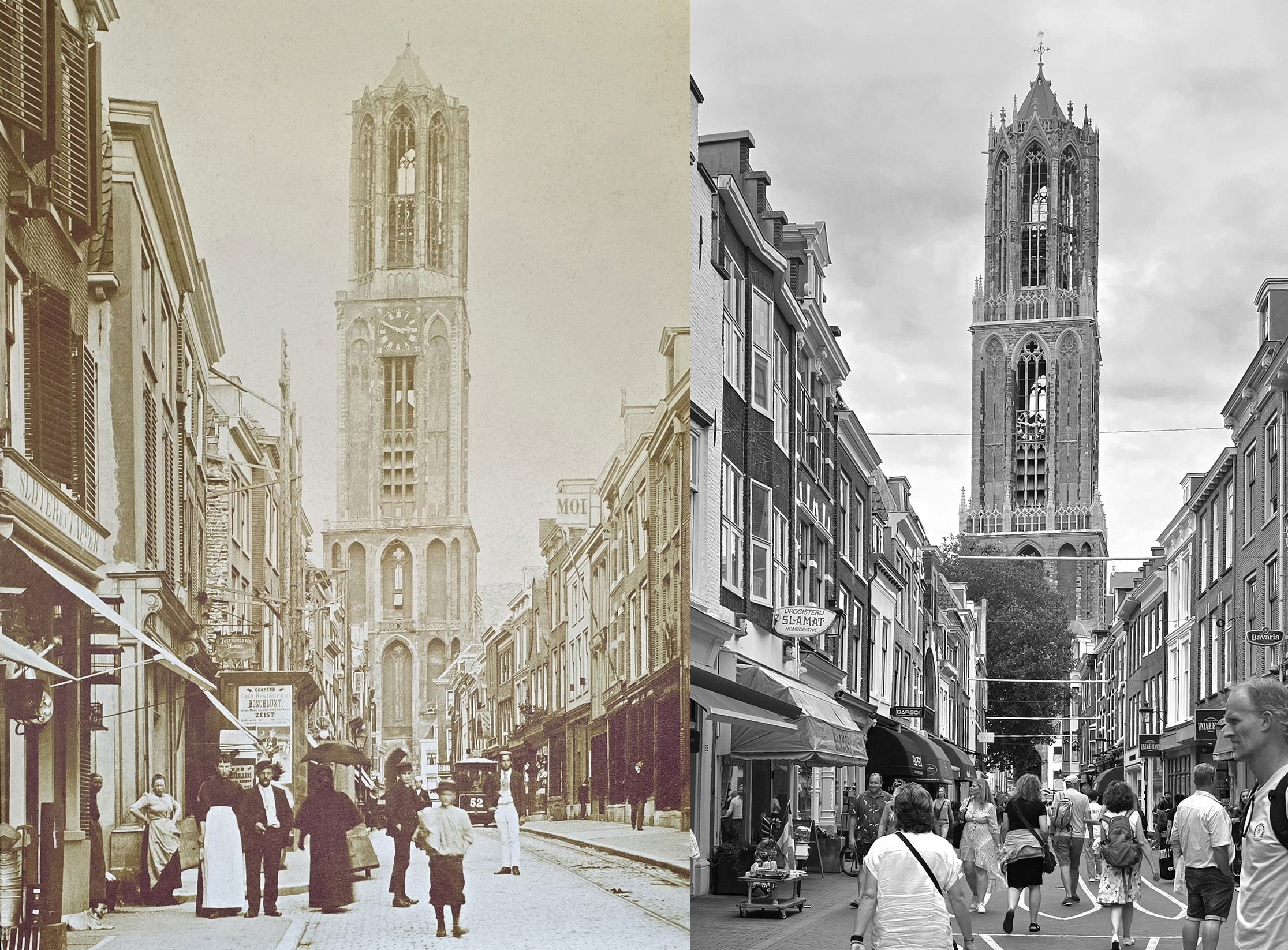
Visit to the Dom Tower
As luck would have it, my wife wanted to visit a colleague at the "De Hoogstraat" rehabilitation center in Utrecht on Sunday afternoon at 2:30 PM. I decided to take her there and walk from there to the Dom Tower. The weather was muggy, and it was much further than Google Maps suggested at 31 minutes. With a brisk pace and sweaty, I arrived at Domplein square via Wilhelminapark (Boschlust was located in Wilhelminapark in Zeist). Wow, it's so busy here, and walking under the Dom Tower, I came out onto Zadelstraat, where I took a photo of the Dom Tower from the same angle as in 1895. To compare the time period of 1895 and 2025, I placed the two photos side by side in Photoshop, and what did I see? There's no such thing as coincidence here either; the clock faces on the Dom Tower show the same time 130 years later, two minutes past the time. Amazing, isn't it? It was meant to be.
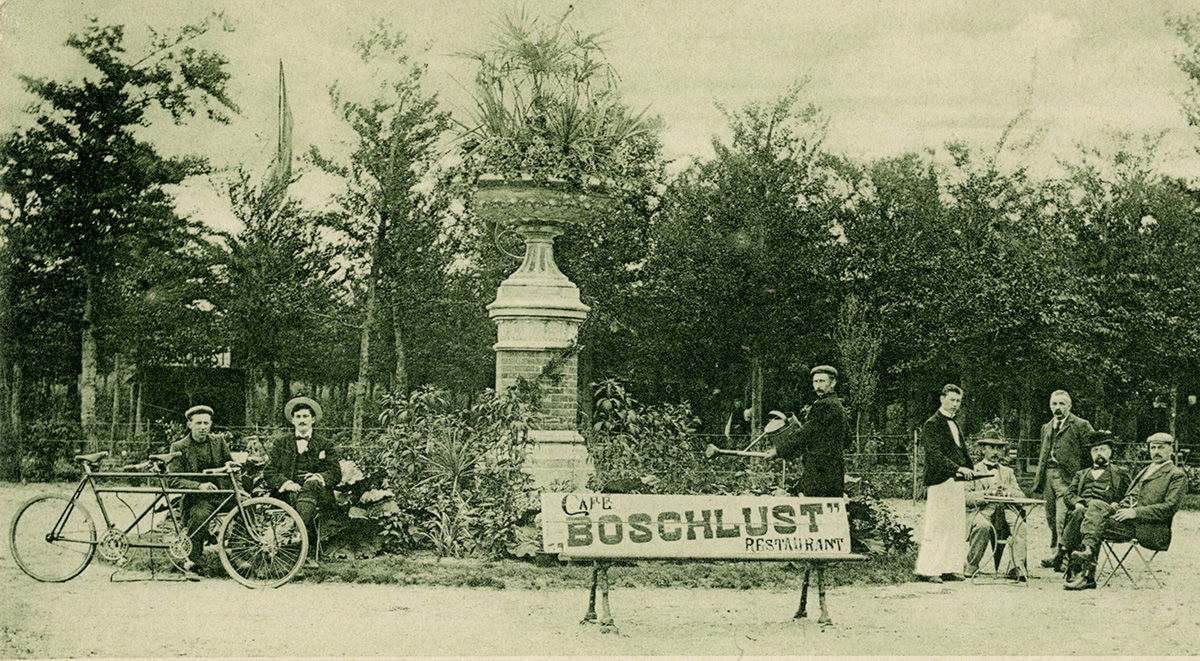
Opening in 1895
Opening in 1895 1895 was the year that Café-Restaurant "Boschlust" opened in Zeist Park, with a dining room for approximately 70 people, a lounge, a billiard room, and 12 rooms. The 5,000 m² garden on Mooie Laantje (present-day Prof. Lorentzlaan) housed eight gazebos, and space was also planned for cricket and a stable for eight horses. Mr. J. Ph. van Beek envisioned his establishment not as a beer hall, but as a place for families to enjoy Zeist's beautiful nature.
To the left of Café-Restaurant Boschlust and in front of the then-unbuilt Sixma-State villa (1905) at Prins Hendriklaan 35, there was a small flowerbed containing a flower vase, surrounded by several benches with tables and chairs where people could relax after a walk or bike ride, or simply enjoy a glass of wine. The flowerbed and vase were donated in 1899 by Mr. J. Muller, who lived at Prins Hendriklaan 31 and overlooked the intersection with Boschlaan. Around 1925, Mr. Muller donated the vase and the flowerbed to the municipality of Zeist.
On December 11 of that same year, a report on the opening appeared in the Zeist Weekbode. It was a good idea of Mr. J. Ph. van Beek, tenant of the recently built recreation center "Boschlust" in Mooie Laantje, to offer the public the opportunity to become acquainted with his establishment by way of invitation. He did this very graciously, with the kind cooperation of Mr. A. Fabries and the gentlemen Van der Bilt of Amsterdam, by offering the guests a lecture interspersed with musical performances, which was a resounding success. It was a pity that more people could not be invited, but they had to make the most of the limited space. Mr. Van Beek, as we have seen, will operate Boschlust on a very respectable scale. He will strive to encourage visitors to return with a good service. Thus proceeding, we expect that many foreigners will visit Boschlust next summer, as the facility meets many a desire: a place of relaxation near the Bosch, where one can, as in the old days, strengthen one's inner self.
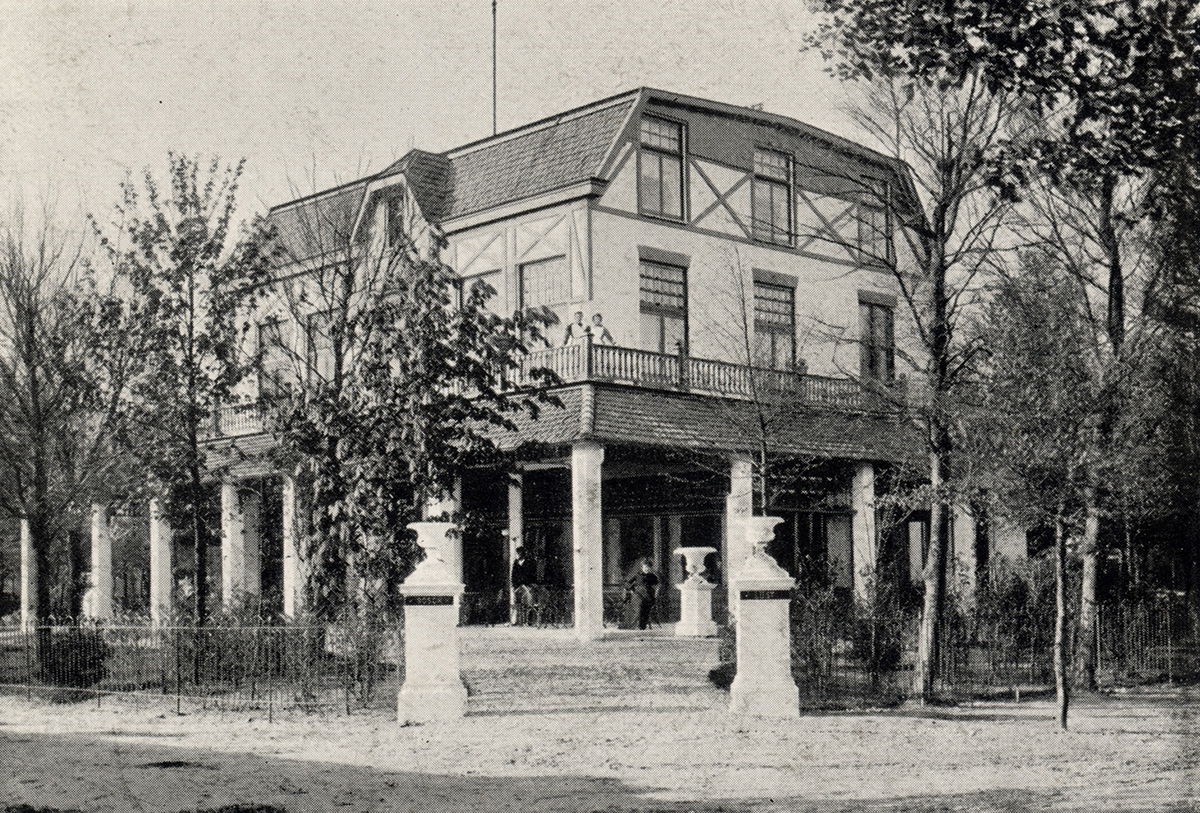
Name changes for Zeister Park and Mooie Laantje
In 1898, the mayor and aldermen, Clotterbrooke Patijn van Kloetinge, decided to rename the park where Boschlust was located, from Zeister Park to Wilhelminapark. The lane at the corner of Parklaan, running to Mooie Laantje, was renamed Boschlaan (now Boslaan) on September 3, 1901, after the nearby Zeister Bosschen (woods), which were purchased by the municipality of Zeist at public auction in 1913. The Wilhelminapark neighborhood is located in the heart of Zeist and is roughly bordered by 2e Hogeweg, Slotlaan, and, turning right at the end of Bethaniëplein, crossing Pauw van Wieldrechtlaan to Laantje zonder Eind (Little Lane without End).
On February 26, 1928, Mooie Laantje was renamed after Prof. Lorentzlaan, named after Prof. Dr. Hendrik Antoon Lorentz (1853-1928), a Dutch physicist and founder of electron theory, paved the way for the theory of relativity. In this theory, the laws of mechanics, or physics in general, cannot depend on the velocity of an observer relative to other observers. He received the Nobel Prize for this in 1902, together with Prof. Dr. Pieter Zeeman.
1901 Sale to Amsterdam Insurance Company "De Atlas"
Boschlust quickly outgrew its current premises as a café-hotel-restaurant, and at the end of 1901, a major renovation was commissioned by the new owner, J. Muller, owner of the Amsterdam Insurance Company "De Atlas." In March 1902, the completely renovated and very pleasantly situated café-restaurant and guesthouse "Boschlust" opened its doors, under the management of director Antoon Frederik Legeer, married to Maria Elizabeth Termeulen. The restaurant offered good food at a reasonable price, as evidenced by the price list: "Plats du Jour" (FJ 0.50 and FJ 0.80). Dinners (FJ 1.50 and FJ 2.00).
However, the establishment soon proved too small, and in 1903, a large hall with a kitchen was built. That same year, Boschlust was connected to the telephone network with telephone number 34. In 1904, a petrol-powered facility to generate electricity for lighting was installed in the garden, and in 1905 a coachman's house was built on Boschlaan.
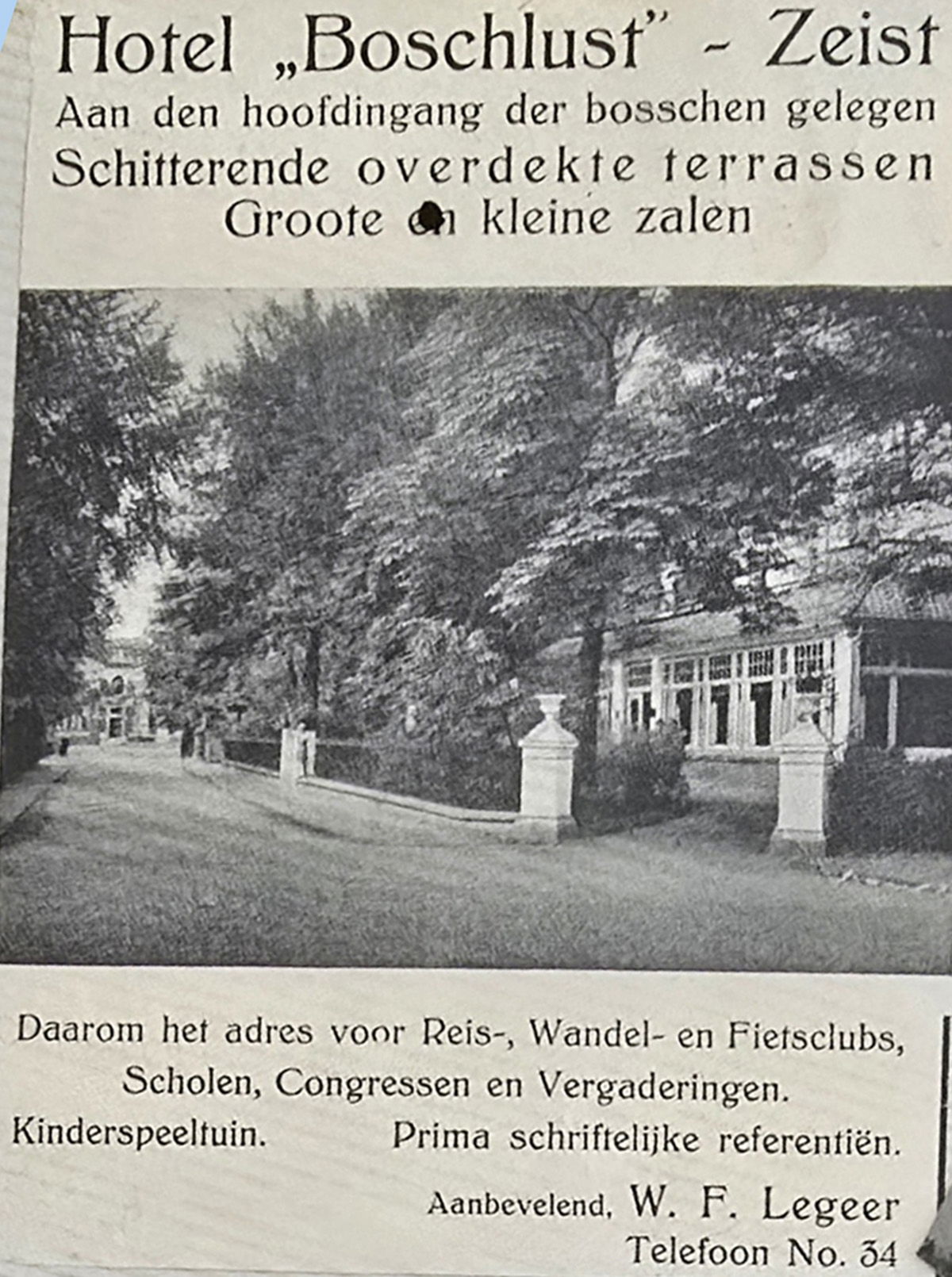
From its early years, and long before "Figi" came into the picture, "Boschlust" was the center of Zeist social life, particularly in the cultural sphere. For example, in 1897, the Zeist Theater Association "De Vriendschap" gave its first concert performance of: A Nihilistic Conspiracy (rejection against prevailing beliefs) and Stutterers in Sorts. A year later, billiard enthusiasts could enjoy the carom billiards table installed by J.J.A. Etmans, and in 1899, the Rumeensche Magnaten Band, along with violin king "Calin Udila," gave a performance in the garden. The Staff Band of the "5th Infantry Regiment," led by director G.K.G. van Aken, gave concerts in the bandstand for many years from July 1900 onward.
Fires
Lightning struck the stables of the Boschlust Hotel in 1909. An initial fire was extinguished with a few fire extinguishers and later with buckets of water. On November 21, 1911, the entire top floor of Boschlust burned down. Only the ground floor remains, albeit with extensive water damage, and of the top floor, only the walls remain. The cause is unknown. Because the Boschlust Hotel was closed during the winter months in those years and was only used for parties, the fire was discovered late. Along with the annexes at Mooie Laantje 19a and 19b and Hotel Parkoord at Slotlaan 49, Boschlust fell under a single management. Reconstruction was completed in 1912, and a grand reopening followed.

Cultural Center
Under Legeer's direction, more and more events were organized, making "Boschlust" the first cultural center in Zeist with a Sociëteit (an exclusive club for upper-class gentlemen). Events included a large vocal and instrumental concert in the Concert Hall in 1905, and that same year, Mr. W. Pottum took off from the garden in his hot air balloon "Kuko," slowly drifting eastward. After floating in the air for about 20 minutes, he landed between "Wallenburg" and Leusden. In 1912, Zeist got its first American cinema at Boschlust, where concerts and film screenings were held weekly on Sunday and Monday evenings at 8 p.m. Films at that time were "moving photographs" without sound (deaf or silent film), but with the help of a pianist and violinist to enhance the atmosphere. These were first-class events, unimaginable even in 2025. Furthermore, one could go there for coffee tables, exhibitions, billiards, conferences, meetings, parties, theater performances, dinners, and so on. From 1918 onwards, the number of film screenings expanded to Wednesday and Saturday evenings, with additional children's programs on Wednesday and Saturday afternoons. Teacher Joh. Steeman gave dance classes with names we no longer recognize today, such as Valse Fantaisie, Salon Tango, Roulli le Roulli, Lulu Todo, Footbol Dance, and many more. There were also public auctions, a Floralia exhibition in the garden with a flower arranging competition. In 1918, there was a performance by the still-existing Harmonie Company "Oefening Baart Kunst" (O.B.K.).
Boschlust went up for public auction three times.
1. In March 1920, the first auction took place for Hotel Boschlust on Mooie Laantje, with two mansions/dependances at nos. 19a and 19b. The lots were offered for a total of ƒ89,450. The new owner was the N.V. Exploitatie Maatschappij Boschlust. A new entrance was built on Mooie Laantje, after which the Hotel-Restaurant-Concert Hall "Nieuw Boschlust" reopened on June 1, 1922, under the management of Messrs. F.H. van der Molen, director, and J.J.M. Dickman, director/manager.
2. On July 26, 1923, another public auction took place for the fully operational hotel-restaurant, complete with a leafy garden, two garages with apartments above, and an outdoor cabaret, concert hall, billiard room, lounge, and café, 14 guest rooms, a bathroom, etc., covering 37.53 acres. The hotel owner of "Nieuw Boschlust" was Mr. J. Th. Dolmans, but in 1925, Mr. A.F. Legeer suddenly reappeared as manager. I believe the annexes were occupied by staff, as the names of the residents changed from time to time over the years. The former annex, the house at Prof. Lorentzlaan 39, still looks the same as it did in those days.
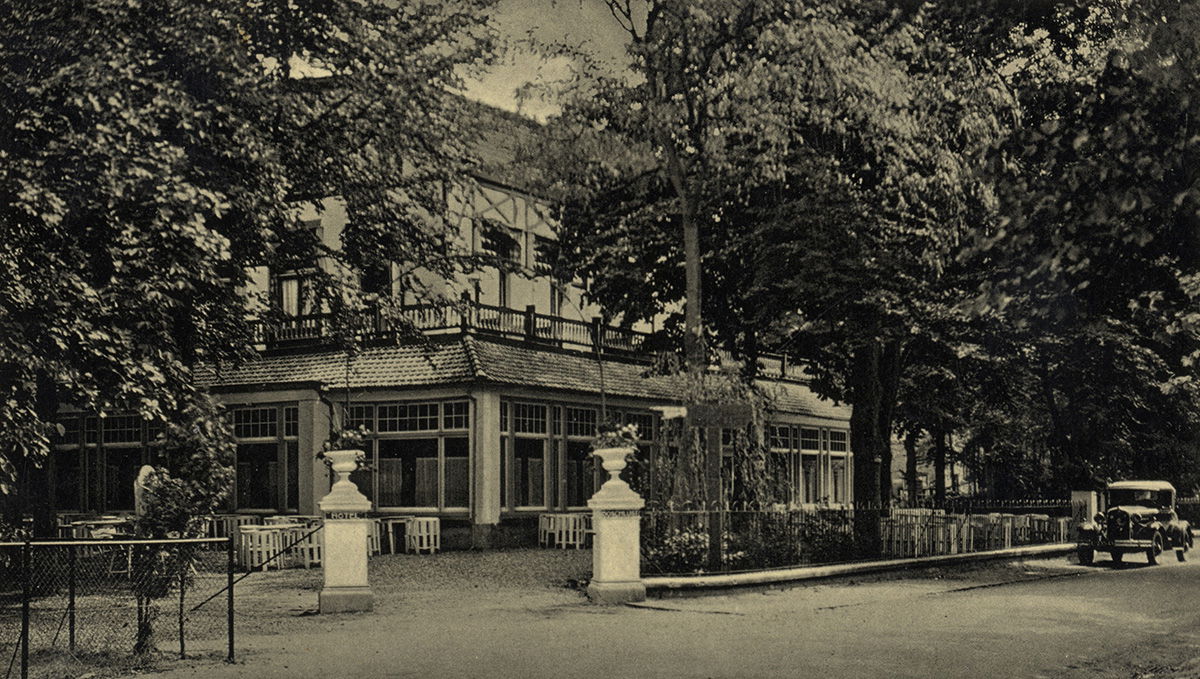
3. After the death of Anton Frederik Legeer in 1928, his widow, Maria Elizabeth Legeer-ter Meulen, was a hotelier until her death in 1933. His son, Willem Frederik Legeer Jr., married to Hendrikje Vlijm, managed the hotel from 1932 until 1934, when Auctioneer J. Beijers in Utrecht ordered a public auction due to bankruptcy.
At his farewell on February 6, 1934, during an art evening at Boschlust, organized by the "Association for the Enhancement of Popular Entertainment," Mr. Bruinooge, chairman, expressed his deep gratitude to Mr. and Mrs. Legeer, who had always been exceptionally helpful to the board during subsequent performances. Experiences similarly expected of Boschlust's new operator, Mr. Hoogland.
1934 Sale to the Hoogland family
In 1934, Gerardus Nicolaas Hoogland and his wife Anna Maria Sluijs purchased Hotel Boschlust, including all its inventory, as required at the public auction and in exchange for cash. Until their departure in 1959, they spared no effort to renovate and maintain the building in a modern-day manner. From 1934 onward, a concert hall was added, a storage room was converted into a conservatory, garages were built, and in 1938, the hotel underwent a significant expansion. It was a successful hotel and apparently so well-attended that a request for boarding houses was made in the weekly newsletter of May 22, 1922.
Numerous events were also immediately organized in the concert hall and theater, such as an exhibition by the Dutch Association of Aquarium Keepers and a celebration of the 83rd birthday of the elderly actress, Mrs. De Boer-van Dijk - The People's Choir "Zeist" with the cooperation of the Children's Choir of students of the Prince Alexander Foundation - The Band "Tot Uw Genoegen" also students of the Prince Alexander Foundation (Institute for the Blind) - Roman Catholic Symphony Orchestra "St. Don Bosco" - Family evenings of the Z.J.G. "Samuël" - Revue "Blokken Weg" played by non-commissioned officers and officials of the Aviation Department, on the occasion of the 25th anniversary of the LVA - National Exhibition of Bakery Products on the occasion of the 30th anniversary of the Zeist Bakers' Patronage Association "Onderling Belang" and opened by the Mayor, Jhr. Dr. M.L. van Holte tot Echten - Propaganda evening of the Roman Catholic Women's Youth Movement at which Chaplain Ruyters thanked Mr. and Mrs. Hoogland for making the hall available free of charge. - Anniversary celebration of Zeist Gymnastics Association "Bato" with revue "Spring Melodies", lectures, etc.
World War II, birth of Wilhelmina's daughter and son Wim hidden in the cellar
In 1939, the hotel and hall were initially used as sleeping quarters for Dutch soldiers, after which the German Wehrmacht requisitioned Boschlust, like many other buildings in Zeist. Theater evenings were held in the theater of the Wehrmacht inn "Boschlust" in favor of the Winter War Relief Work. Tickets were available from the local commander at Donkerelaan 10 (present-day Slotlaan).
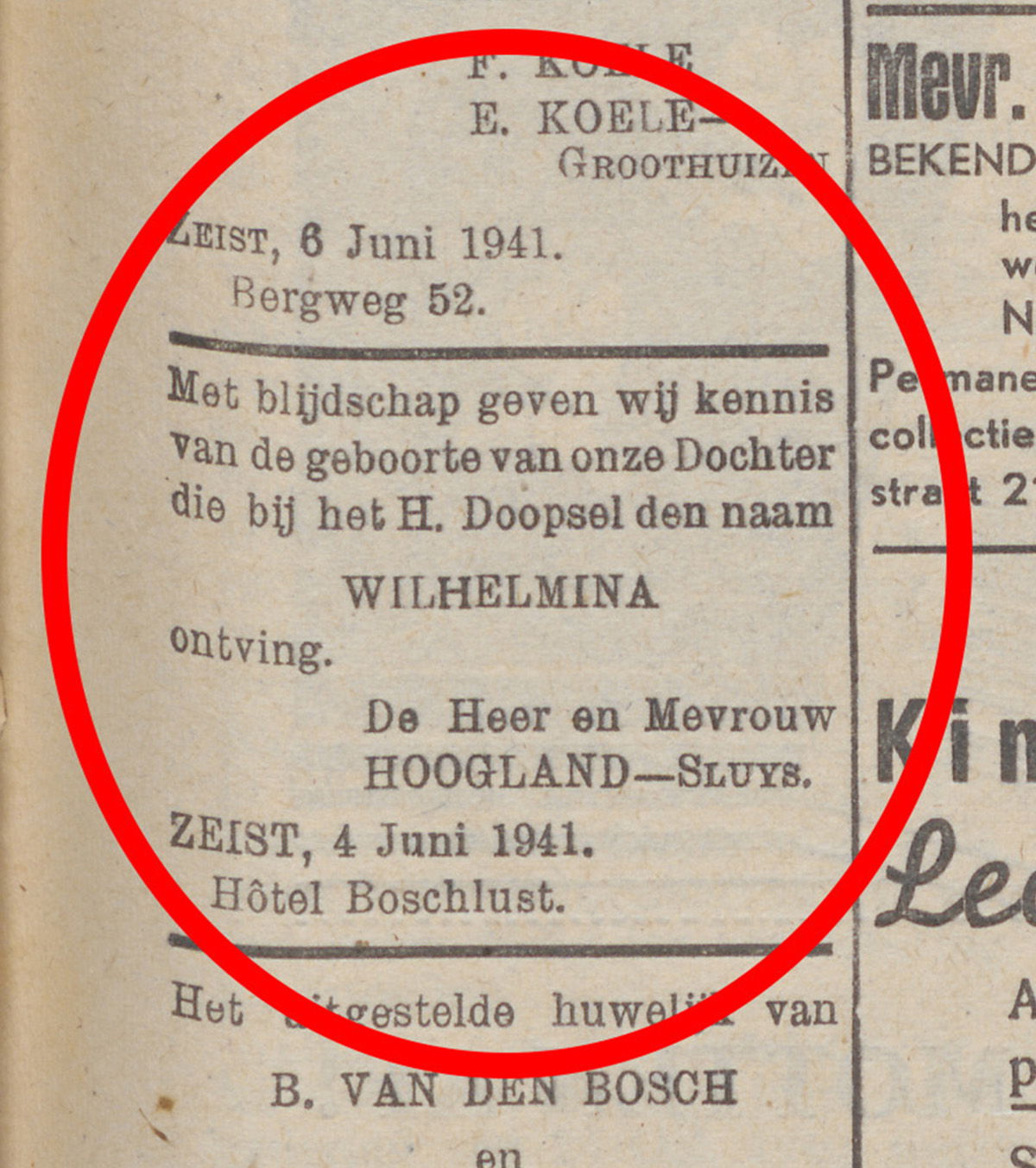
A daring advertisement appeared in the Weekbode Zeist newspaper on June 7, 1941, stating: "We are pleased to announce the birth of our daughter, who received the name WILHELMINA at her Holy Baptism. Mr. and Mrs. Hoogland-Sluijs." The German occupiers had banned royal names and could have seen this announcement as a provocation.
Another daring act: son Wim Hoogland, who was almost eighteen at the end of the war, hid for a long time in a small space in the cellar beneath the living room when danger arose. This was not without danger, as German soldiers occupied the hotel. A friendly German soldier warned him when they were looking for him again, so he could hide in time. At the end of the war, he risked being briefly sent to Germany as a forced laborer (Arbeitseinsatz). The Germans knew he had to be hiding somewhere and, during searches, shot several times through the living room floor, but missed him because he was hiding in a small space behind a wall just beyond the living room. By the end of 1944, approximately 275,000 Dutch people (7.7 million people worldwide) were forced to work in Germany.
When the Germans retreated, Canadian and English liberators stayed at Boschlust for several months, after which it was once again at the disposal of the owner-operator, Mr. Hoogland. Numerous renovations immediately followed, including those of the hall, restrooms, foyer, and other areas, and several rooms were also demolished to improve Boschlust's appearance. From November 9, 1945, cinemas were reopened, and after the restoration of the interior, the main auditorium, foyer, and conservatory, visitors could once again enjoy the performance of the Dutch Operetta Studio, featuring the love story of and about Countess Maritza, with the moving music of E. Kalkmán, performed by a capable orchestra conducted by Jos Silberman. Mr. Hoogland expressed his satisfaction to a sold-out audience, and his request to express his joy in a dignified manner by singing our old Wilhelmus (Dutch national anthem) together was gladly granted. On February 17, 1946 there was an exclusive Variety Program with, among others, “Lou Bandy” - “3 Rethlems” School of Acrobatics - “The Martini’s” The Elegant Dancing Couple - “Fred. Allistar with Assistant” famous people then and now - “Ted Valerio” Tempo on the Accordion and “John van Beest” Confereert.
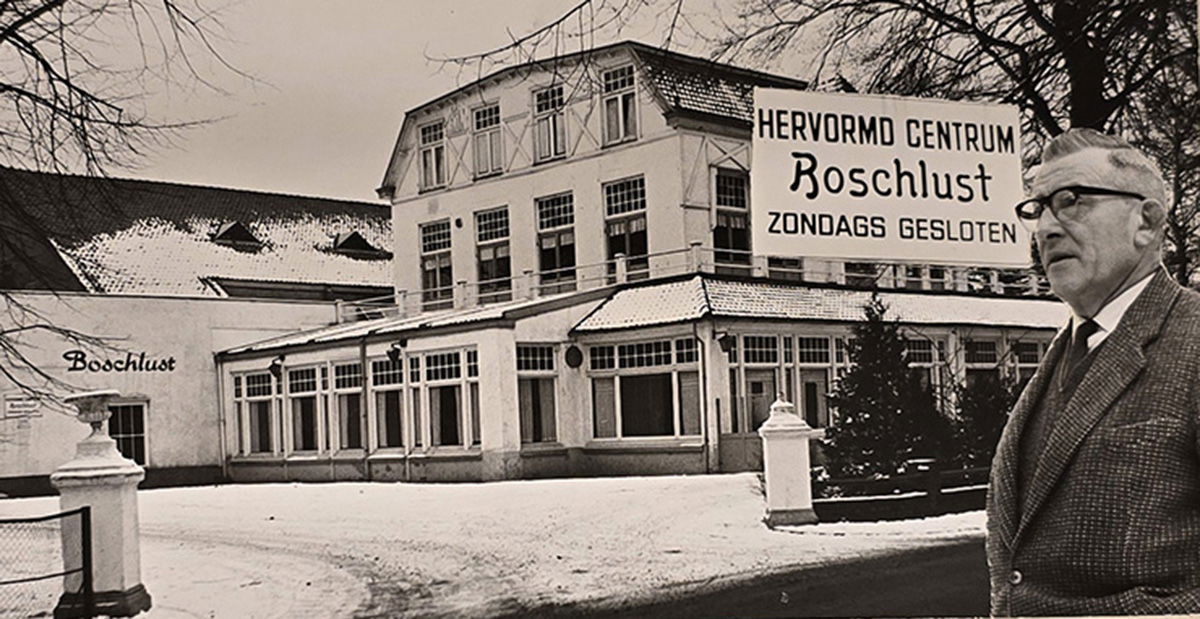
1959 Sale of Boschlust
Because the municipality of Zeist was not interested, Mr. Hoogland sold Boschlust in 1959 to the Church Council of the Dutch Reformed Church, Boulevard 2a in Zeist. The congregation used Boschlust as a Reformed Church Center, but first had the main hall fitted with new windows. Anton Breijer became the manager.
1964 Sale to the Municipality of Zeist
Boschlust was too large for the congregation, and at the end of 1964, the Church Council sold "Boschlust" for 475,000 guilders to the municipality of Zeist, which suddenly showed interest in the building. On December 1st, Boschlust came under the management of the Foundation Council of the "Stichting Boschlust" (Boschlust Foundation). Wilhelmus Nicolaas Maria (Wim) Hoogland and his wife Riet Bruins were both appointed directors of the "Boschlust" institution. I find the word "institution" somewhat gloomy and sounds as if you're talking about a prison or a home. The municipal council explained Wim Hoogland's appointment as director as follows. After Mr. Hoogland Sr. transferred ownership of Boschlust to the Dutch Reformed Church, his son Wim, who had managed the operation for the past few years, acquired ownership of a hotel called "Hoogland" in Blerick, near Venlo, which he has successfully operated for the past few years. Boschlust thus gains a manager who knows the business inside and out and undoubtedly has a passion for making it work and ensuring its successful operation, in accordance with the wishes of the Foundation Board established for this purpose. The newspaper headlines read, "Another Hoogland in Boschlust."
First, the Boschlust building was designated as a "Meeting Room," and the "Boschlust Foundation" was granted a temporary exemption until January 1, 1966, under the 1932 Alcohol Act. Starting January 1, 1965, Hoogland was allowed to live in the building with his family, enjoying free housing, free food, free water, heat, and light. This seems like a generous arrangement, but Mrs. Hoogland, as director, received no salary. She was the one behind the stove and in charge of the kitchen, where approximately 350 meals were prepared at a time. Together they ran the business, and behind the scenes, according to her husband, she was indispensable, the one who pulled the strings and worked incredibly hard.
A Troubled History
The history of Boschlust is one of continuous renovations, additions, reopenings, financial losses, endless council meetings, and restarts. The Cultural Center has undergone numerous internal and external renovations to modernize and maintain its operational status, reopening after major renovations in 1966, 1975, and 1986. The ninetieth anniversary in 1985 was celebrated with great fanfare.
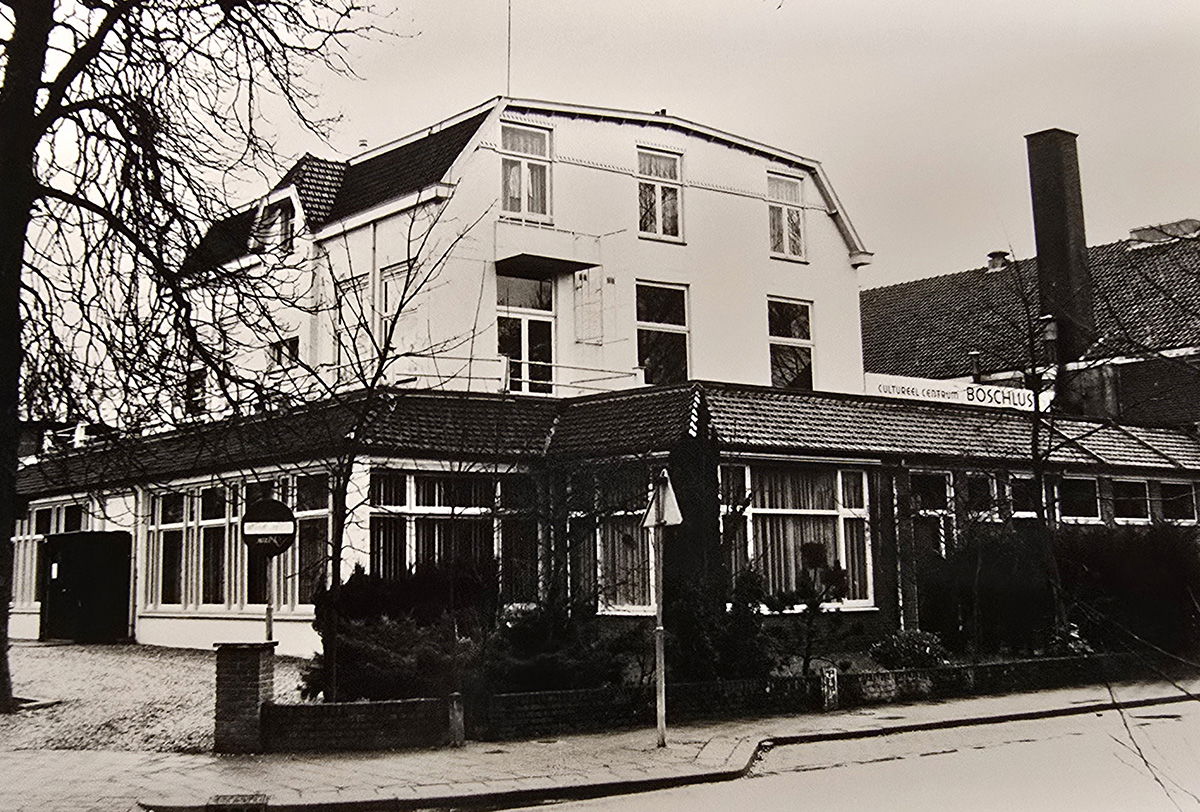
The Zeist hospitality industry, and Figi in particular, accused the municipality of unfair competition because the full costs of renting out the premises to associations and private individuals were not allocated. Figi had long been seeking to improve productivity, which is why they objected to the activities in Boschlust, which the municipality was having to contribute to. Boschlust, the stepchild on which Zeist's community life depended, ultimately proved to be a financial burden for the municipality, and the council decided it should be removed from the municipal books by January 1, 1989.
During the debate on Tuesday, April 14, 1987, the council was asked to choose: either renovate Boschlust thoroughly for ƒ 1,100,000 or privatize it. It appeared that discussions had already been held with various parties regarding privatization, and it was stated that the interests of the community were paramount. The mayor and aldermen indicated that they no longer wanted to invest in Boschlust and that they wanted to sell it to private individuals.
In 1988, Figi "Golden Tulip" presented construction plans for a luxury five-star meeting and conference center with numerous halls, including a 600-seat venue and one hundred hotel rooms. Gerard Ruys, with Figi, was eager to take over Boschlust's role as the local cultural center. CDA Alderman Theo Ruys, a brother of Figi's director, was a stakeholder in the family business, and VVD Alderman Jan van Halteren, a commissioner at the Van Veenendaal company, which wanted to develop the area between Boslaan and Prof. Lorentzlaan, also withdrew from the Boschlust negotiations.
A buyer for Boschlust was found in Nico and Janny Jansen of the Rettichini and Wildschut Dance Academy, but they withdrew after a disagreement with the municipality about the purchase. After Mr. and Mrs. Hoogland left in 1989, the municipality decided to keep the Boschlust cultural center open for at least another two years, and as much longer as necessary. A temporary leader was appointed for Boschlust to ensure the continued activities of the cultural association.
Retirement
In February, Wim Hoogland and his wife Riet retired through the early retirement scheme. Together, these hardworking hospitality entrepreneurs, originally from hoteliers, had been there for everyone day and night for 25 years, with limited resources. The farewell on Thursday evening, February 16, 1989, at Boschlust, hosted by the associations and attended by five hundred people from the cultural scene, was the true farewell for the couple. The official farewell reception for Wim and Riet Hoogland followed on Saturday, February 18, and the couple could begin to enjoy their well-deserved retirement.
Events and performances at Boschlust since 1964
Boschlust has been used by numerous organizations. A random selection includes: Vereniging Tot Steun, West-End, Arma, Antonpark, Polyhymia, Genesius Theater Association, Kunst na Arbeid (Art after Labor), Dijnselkwartier, Laus Deo, Playground Federation, Zeist Men's Choir, Book Ball, Chess Club, Slotridders (Castle Knights), Walking Club, Playground Federation, Orange Association, Women's Association, Philharmonic Orchestra, Jong en Vrolijk (Young and Happy) Singing Association, neighborhood associations, Sinterklaas celebrations, Christmas celebrations, Card Games, Shuffleboard, New Year's Concert by the Royal Harmony Society (OBK), and music bands: Voorwaarts, Dr. Engelhardt Corps, Jonathan, Erica, hairdressing exams, Citizens' Day for young voters, housewives' association, and also school communities such as Dijnselburg, Patijnschool, Kerckeboschschool, Zeist Free School, Moravian Church schools, Zeist School Association, staff association parties, exhibitions, student parties, the Mars and Bato gymnastics clubs, conferences, council meetings, U.L.O. Prof. Lorenzlaan, Federation of Women's Voluntary Aid, Meeting of the National Women's Council of the Netherlands, ballet performances by the Rettichini dance school, graduation ball at the Wildschut dance school, dance evenings, theater performances, weddings, company parties, meetings, accordion competitions, carnival festivities by De Slotnarren, monthly get-togethers, weddings, Zeist Philharmonic Orchestra and the Zeist Youth Orchestra, walking association N.T.V. Never Too Far, etc. Professional artists like André van Duin, The Mounties, Mini & Maxi, Neerlands Hoop in Bange Dagen, Massada, Toon Hermans, Paul van Vliet, Snip en Snap, Pipo the Clown with Mamaloe and the Indian Kluk Kluk, Cuby & the Blizzards, Louis van Dijk, and Pim Jacobs, among others, also found Boschlust. On October 9, 1991, Mr. P. van Vollenhoven of the Zeist victim support office opened the event.
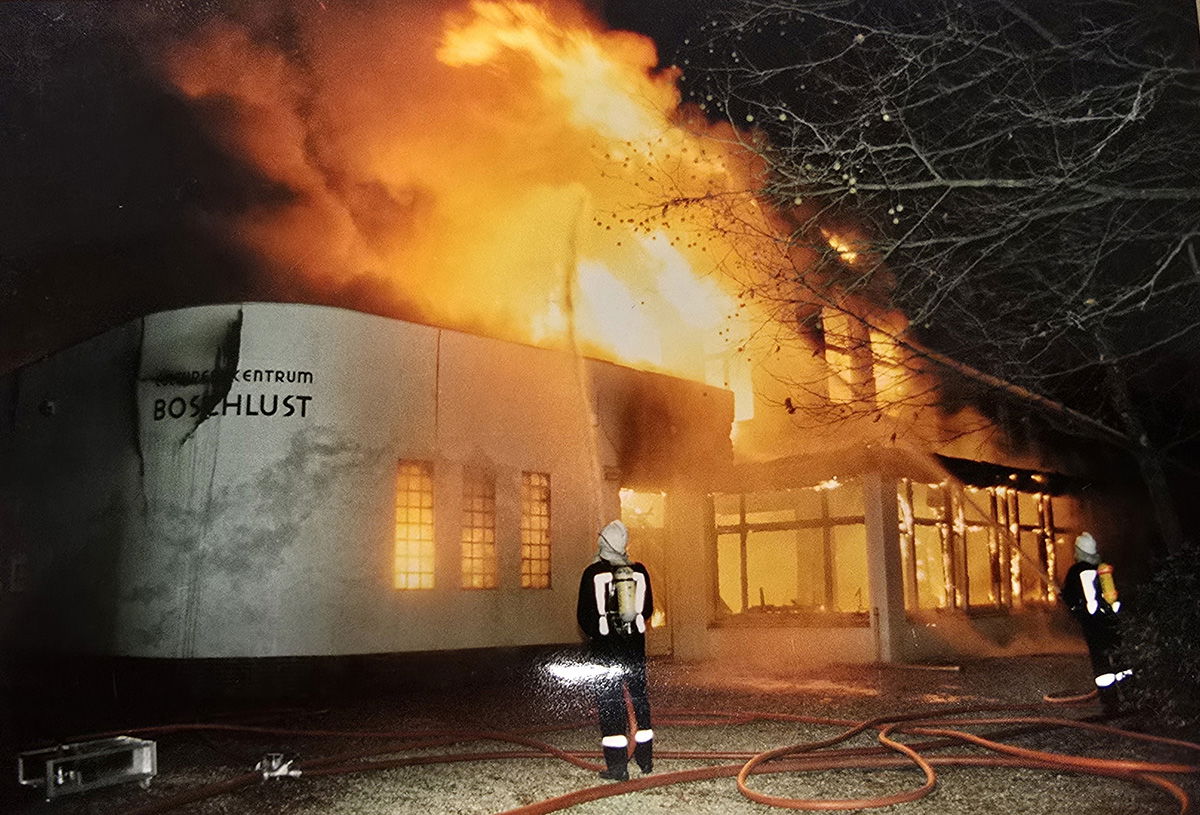
1993 The Great Fire and the Curtain Falls
A blazing fire largely destroyed the legendary Boschlust Cultural Center in Zeist on Saturday, November 13, 1993. Virtually nothing remained of the foyer, restaurant, and kitchen. The theater hall was still partially intact. According to Mayor R. G. Boekhoven, Boschlust would likely not be rebuilt. The intention was already to sell it to a developer because, starting in January 1995, all cultural activities would be held in the new Figi theater on Het Rond. Churches and associations offered space for the continuation of the activities of Zeist's community life.
And so, the curtain fell prematurely for the Boschlust Cultural Center. In 1994, the building was demolished, and 13 houses were built on the vacant site on the corner of Boslaan and Prof. Lorentzlaan. On August 8, 2000, the public road leading to the former and famous Cultural Center "Boschlust" was given the name Boschlust.
You can find the original drawings of Café-Restaurant, permits, drawings, photos, and advertisements from 1895 in the photo gallery at https://www.als-bomen-en-stenen-konden-praten.com/galerij
Zeist is so beautiful, and we're so lucky to live here.
Arnie Della Rosa
Want to comment on a story? Please include your name and email address with your comment so I can respond if necessary. Don't want to miss anything and receive an automatic notification when a new story is published? Send an email to avanr1956@gmail.com and I'll add you to the mailing list.
You can read my hiking stories at https://www.als-bomen-en-stenen-konden-praten.com